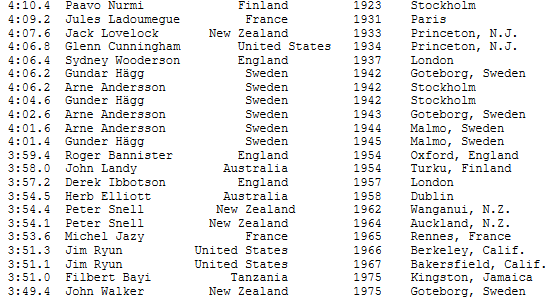Who knows who John Landy is?
I will give you a bit of blank space to ponder your answer…
So if you’re a seasoned pub-quizzer (or a smart-ass) you might know who this is. You therefore might also know Derek Ibbotson, Herb Elliot, Peter Snell, Michael Jazy, et al.
If you’re still in the dark – then you have almost certainly heard of Roger Bannister.
Up until the 1950s no one ever thought it would be possible to break the 4 minute mile. Roger Bannister was the innovator in 1954. And everyone remembers his name.
John Landy subsequently broke this milestone (pun intended) 2 months later. But is not a household name outside of Melbourne, Australia. This has since been broken 1,500 times, by the likes of Derek Ibbotson and friends. And in our lifetime the sub-2-hour marathon will probably be broken too – a feat which also seemed impossible in the not too distant past.

This isn’t a post about ‘first is everything’, nor is it ‘innovate or don’t bother else no one will remember you’ – it is about how things that seemed outside your wildest dreams can become obtainable (and eventually fairly customary) as the world changes.
I have always been sold on the merits of predictive risk modelling. In 2011 I was shown ‘the combined model’ by the Nuffield Trust – a healthcare based model for predicting patients at risk of unplanned and unnecessary hospital admissions.
That is when my love story with predictive analytics began. And so with colleagues in the service we built a risk model using education data to predict risk of NEET (Not in Education Employment and Training).
Fast forward 5 years and Essex Data projects started expanding upon the implementation of predictive analytics. However, we recognised that intelligence exists across different services and data-sets. And so Essex Data had two core principles: bringing together data and intelligence across the county to; apply predictive analytics methodologies for improving the lives of the people and communities in Essex. Further detail can be found at the Future of Essex portal.

Essex Data projects include: improving school readiness; co-ordinating domestic abuse intelligence and; understanding hotspots of violent crime and gang activity. The value in this collaboration has been recognised and hence the Essex Innovates programme of work is the driving force behind scaling this up to be able to tackle more issues together in smarter ways.
Which brings me back to Roger Bannister (and John Landy). To repeat, I have always been sold on the merits of predictive risk modelling – but 8 years ago this was unheard of in the public sector and not everyone was convinced. (Much like those who suggested it would not be possible to break the 4 minute mile).
The world is different in 2019. The tools and resources for processing and analysing data have improved dramatically – and the techniques that the private sector have mastered for improving sales/churn/customer experience are becoming prominent (and expected) within the public sector.
Our next two projects are bringing together data and intelligence to try and predict and prevent: homelessness and; mental health crisis prevention. Two areas of great importance to ourselves and partners.
We will update you on the progress of these projects through a variety of channels, but are also planning some public engagement so we can ensure the public voice is represented in our plans.
Our end game is to tackle more and more issues earlier through the smarter use of data. We are currently in the midst of a data revolution - NOW is the time to be doing this. We might not be Roger Bannister or even John Landy (our colleagues in the private sector have paved the way for predictive analytics) but we have the tools, skills, intelligence and motivation in place to explore the use of predictive analytics for social good. And that can only be good.